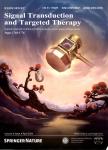How to package and SEND mRNA: a novel “humanized” vector system based on endogenous retroviruses
作者机构:Research Dept.Cell&Gene TherapyDept.of Stem Cell TransplantationUniversity Medical Centre Hamburg-Eppendorf(UKE)Hamburg 20246Germany
出 版 物:《Signal Transduction and Targeted Therapy》 (信号转导与靶向治疗(英文))
年 卷 期:2021年第6卷第12期
页 面:3367-3368页
核心收录:
学科分类:0710[理学-生物学] 0831[工学-生物医学工程(可授工学、理学、医学学位)] 1002[医学-临床医学] 1001[医学-基础医学(可授医学、理学学位)] 08[工学] 0836[工学-生物工程]
基 金:This work has been supported by the Deutsche Forschungsgemeinschaft(DFG)within SFB841/SP2(80750187)
主 题:endogenous system entirely
摘 要:A recent publication in Science describes a novel mRNA delivery system termed SEND,entirely consisting of endogenous proteins.1 These virus-like particles(VLPs),able to deliver mRNA of e.g.,Cas9,represent a new class of gene transfer *** development of efficient,specific,and safe vectors for the delivery of nucleic acids and proteins remains one of the biggest challenges in gene therapy,particularly for in vivo *** currently preferred viral vectors have several limitations,including biosafety issues,laborious and expensive manufacture,as well as the impossibility of multiple applications due to the inherent immunogenicity of viral *** contrast,non-viral vectors are much easier to produce on a large scale,but have not yet reached gene transfer rates comparable with viral vectors.



